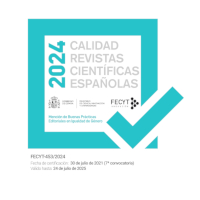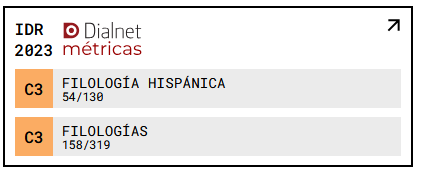Michael Field’s "Long ago" (1889) as a paradigm of intertextual theory: from strangeness to metaxology
DOI:
https://doi.org/10.18172/cif.3442Keywords:
Long Ago, Michael Field, Sappho, intertext, rewritingAbstract
In this essay, I seek to tackle the question of how Katherine Bradley and Edith Cooper articulate their intimate dialogue with Sappho’s poetry in their first volume of poetry, Long Ago (1889), published under the pseudonym of Michael Field. My response to this question translates into a thoroughgoing reflection that interprets Long Ago as a dense and audacious text in which the very ontology of art is revised and recast into ambivalent and open relations. The primary conclusion I reach is that the volume constitutes a paradigm of intertextual theory in use that opens up complex, unstable and fertile encounters between the English self and the Greek other, the translatable and the sublime, the mimetic and the original, the empathetic and the distant, the reparative and the fragmentary, the anti-type and the type, or the immanent and the transtextual.
Downloads
References
ALLEN, G. (2000). Intertextuality. London and New York: Routledge. DOI: https://doi.org/10.4324/9780203131039
BAKHTIN, M. (1984). Problems of Dostoevsky’s Poetics. Minneapolis: University of Minnesota Press. DOI: https://doi.org/10.5749/j.ctt22727z1
BAKHTIN, M. and VOLOSINOV, V. N. (1986). Marxism and the Philosophy of Language. Cambridge MA: Harvard University Press.
BARTHES, R. (1975). The Pleasure of the Text. New York: Hill and Wang.
BENJAMIN, W. (2000 [1923]). “The Task of the Translator” in The Translation Studies Reader. (Ed. L. Venuti). London and New York: Routledge.
BLOOM, H. (2003 [1975]). A Map of Misreading. New York: Oxford University Press. DOI: https://doi.org/10.1093/oso/9780195162219.001.0001
COUPE, L. (1997). Myth. London: Routledge. DOI: https://doi.org/10.4324/9780203286005
DERRIDA, J. (1967). L’écriture et la différence. Paris: Éditions du Seuil.
DESMOND, W. (2012). The William Desmond Reader. (Ed. C. B. Simpson). Albany: State University of New York Press.
DESMOND, W. (2016). The Intimate Universal: The Hidden Porosity Among Religion, Art, Philosophy, and Politics. New York: Columbia University Press. DOI: https://doi.org/10.7312/desm17876
DICTIONNAIRE DE FRANÇAIS LAROUSSE. Online Edition.
DONOGHUE, E. (2014 [1998]). We are Michael Field. Basingstoke and Oxford: Bello.
DUBOIS, P. (1995). Sappho is Burning. Chicago: The University of Chicago Press.
ECO, U. (1989 [1960]). The Open Work. Cambridge: Harvard University Press.
EVANGELISTA, S. (2009). British Aestheticism and the Ancient Greece: Hellenism, Reception, Gods in Exile. Basingstoke: Palgrave Macmillan. DOI: https://doi.org/10.1057/9780230242203
EVANGELISTA, S. (2013). “Greek Textual Archaeology and Erotic Epigraphy in Simeon Solomon and Michael Field”. Cahiers victoriens et édouardiens 78 <http://cve.revues.org/909> DOI: 10.4000/cve.909>. (Accessed 18 July 2017). DOI: https://doi.org/10.4000/cve.909
FADERMAN, L. (1981). Surpassing the Love of Men. London: Junction Books.
FIELD, M. (1889). Long Ago. London: George Bell and Sons.
FIELD, M. (1892). Sight and Song. London: Elkin Matthews and John Lane.
FIELD, M. (1933). Works and Days: From the Journal of Michael Field. (Ed. T. Sturge Moore). London: John Murray.
FUCHS, W. W. (1976). Phenomenology and the Metaphysics of Presence: An Essay in the Philosophy of Edmund Husserl. The Hague: Martinus Nijhoff. DOI: https://doi.org/10.1007/978-94-010-1387-1
GADAMER, H. G. (1977). Philosophical Hermeneutics. Berkeley: University of California Press.
GILBERT, S. and GUBAR, S. (1979). The Madwoman in the Attic: the Woman Writer and the Nineteenth-Century Literary Imagination. New Haven and London: Yale University Press.
GILBERT, S. and GUBAR, S. (1984). “Sapphistries”. Signs: Journal of Women in Culture and Society 10 (1): 43-62. DOI: https://doi.org/10.1086/494113
HALL, E. (2014). “Is the Study of Greek and Latin Classics Elitist?”. Journal of Classics Teaching 29 (8-10).
HEGEL, G. W. F. (1873 [1830]). The Logic of Hegel, Translated from the Encyclopedia of the Philosophical Sciences. Oxford: Oxford University Press.
HERMANS, T. (2009). “Hermeneutics”. Routledge Encyclopedia of Translation Studies (2nd ed.). London and New York: Routledge.
HUGHES, L. K. (2010). The Cambridge Introduction to Victorian Poetry. Cambridge: Cambridge University Press. DOI: https://doi.org/10.1017/CBO9780511780585
HYDE, G. M. (2006). “Translation” in The Routledge Dictionary of Literary Terms. (Eds. P. Childes and R. Fowler). London and New York: Routledge.
HYLTON, P. (2016). “Willard van Orman Quine” in The Stanford Encyclopedia of Philosophy. <https://plato.stanford.edu/archives/win2016/entries/quine>. (Accessed 29 July 2017).
KRISTEVA, J. (1980). Desire in Language: A Semiotic Approach to Literature and Art. New York: Columbia University Press.
LARDINOIS, A. (1997). “Who Sang Sappho’s Songs?” in Reading Sappho: Contemporary Approaches. (Ed. E. Greene). Berkeley: University of California Press: 150-172. DOI: https://doi.org/10.1525/9780520918061-013
LEIGHTON, A. (1992). Victorian Women Poets: Writing Against the Heart. New York: Harvester Wheatsheaf.
LEVI-STRAUSS, C. (1962). La pensée sauvage. Paris: Plon.
MADDEN, E. (2008). Tiresian Poetics: Modernism, Sexuality, Voice, 1888-2001. Madison: Fairleigh Dickinson University Press.
MAKKREEL, R. A. (1999). “Einfühlung” in The Cambridge Dictionary of Philosophy. Cambridge: Cambridge University Press.
MAXWELL, C. (2009). Second Sight: The Visionary Imagination in Late Victorian Literature. Manchester: Manchester University Press. DOI: https://doi.org/10.7228/manchester/9780719071447.001.0001
OLVERSON, T. D. (2009). “Libidinous Laureates and Lyrical Maenads: Michael Field, Swinburne and Erotic Hellenism”. Victorian Poetry 47 (4): 759-802. DOI: https://doi.org/10.1353/vp.0.0086
OSTRIKER, A. (1982). “The Thieves of Language: Women Poets and Revisionist Mythmaking”. Signs: Journal of Women in Culture and Society 8 (1): 68-90. DOI: https://doi.org/10.1086/493943
PATER, W. (1910). The Library Edition of the Works of Walter Pater. London: Macmillan.
PRINS, Y. (1999). Victorian Sappho. Princeton: Princeton University Press. DOI: https://doi.org/10.1515/9780691222158
REYNOLDS, M. (2001). The Sappho Companion. London: Vintage.
REYNOLDS, M. (2003). The Sappho History. Basingstoke: Palgrave Macmillan.
RICH, A. (1972). “When We Dead Awaken: Writing as Re-Vision”. College English: Women, Writing and Teaching 34 (1): 18-30. DOI: https://doi.org/10.58680/ce197218299
RICOEUR, P. (2006). On Translation. New York: Routledge.
SANDERS, J. (2016). Adaptation and Appropriation. New York: Routledge. DOI: https://doi.org/10.4324/9781315737942
SIM, S. (2001). The Routledge Companion to Postmodernism. London and New York: Routledge.
STEINER, G. (2000 [1975]). “The Hermeneutic Motion” in The Translation Studies Reader. (Ed. L. Venuti). London and New York: Routledge.
STURGEON, M. (1922). Michael Field. London: George G. Harrap & Co.
SYMONDS, J. A. (1873). Studies of the Greek Poets: Second Series. London: Smith, Elder, & Co.
THAIN, M. (2007). “Michael Field” Poetry, Aestheticism, and the Fin de Siècle. Cambridge: Cambridge University Press. DOI: https://doi.org/10.1017/CBO9780511484933
THAIN, M. and PAREJO VADILLO, A. (Eds.) (2009). Michael Field, The Poet. Published and Manuscript Materials. Toronto: Broadview Editions.
WHARTON, H. T. (1907 [1885]). Sappho: Memoir, Text, Selected Renderings and a Literal Translation. London and New York: John Lane Company.
Downloads
Published
How to Cite
Issue
Section
License
The authors retain copyright of articles and authorize CIF the first publication. They are free to share and redistribute the article without obtaining permission from the publisher as long as they give appropriate credit to the editor and the journal.
Self-archiving is allowed too. In fact, it is recommendable to deposit a PDF version of the paper in academic and/or institutional repositories.
It is recommended to include the DOI number.
This journal is licensed under a Creative Commons Attribution 4.0 International License














